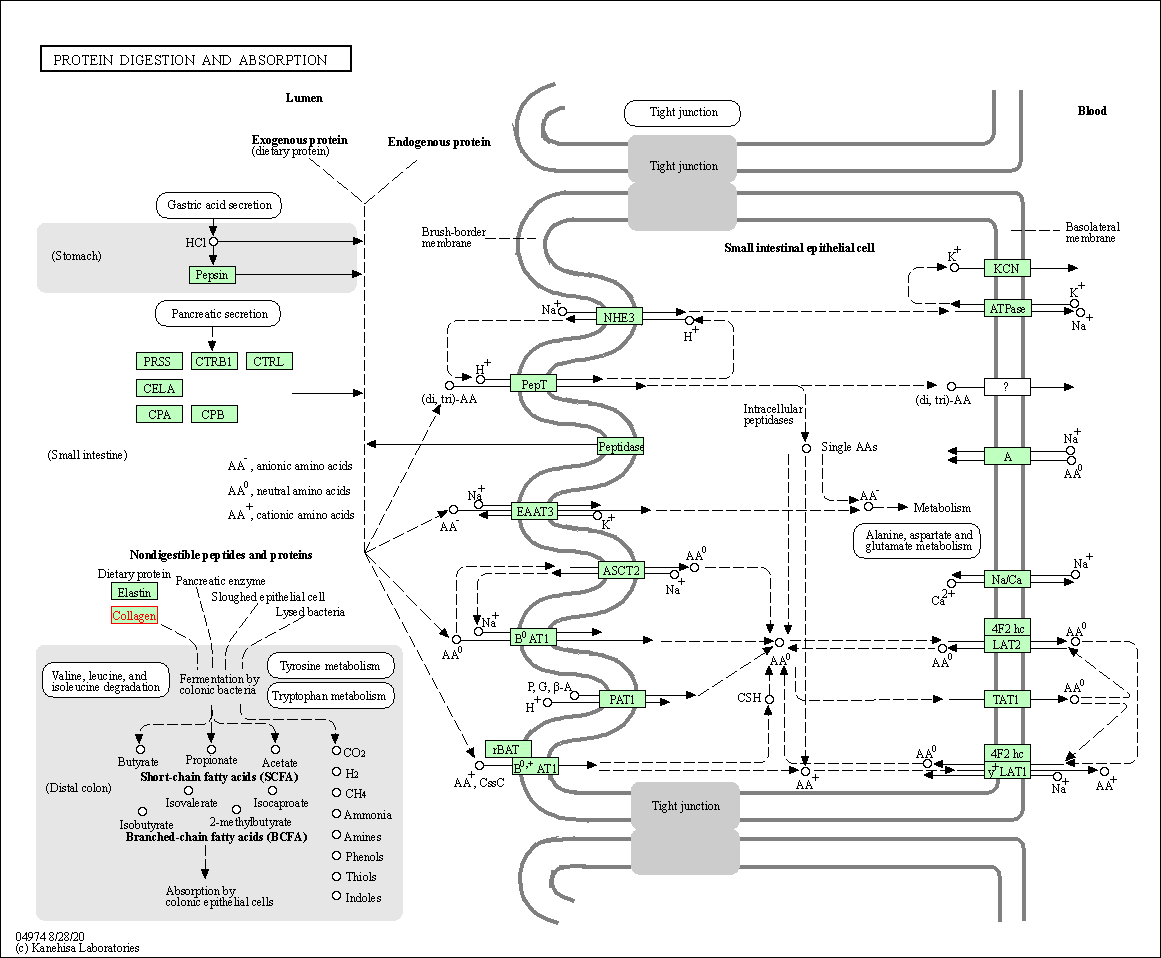Target Information
| Target General Information | Top | |||||
|---|---|---|---|---|---|---|
| Target ID |
T96876
(Former ID: TTDI02479)
|
|||||
| Target Name |
Collagen VII (COL7A1)
|
|||||
| Synonyms |
Longchain collagen; Long-chain collagen; LC collagen; Collagen alpha1(VII) chain; Collagen alpha-1(VII) chain
Click to Show/Hide
|
|||||
| Gene Name |
COL7A1
|
|||||
| Target Type |
Clinical trial target
|
[1] | ||||
| Disease | [+] 1 Target-related Diseases | + | ||||
| 1 | Epidermolysis bullosa [ICD-11: EC3Z] | |||||
| Function |
Stratified squamous epithelial basement membrane protein that forms anchoring fibrils which may contribute to epithelial basement membrane organization and adherence by interacting with extracellular matrix (ECM) proteins such as type IV collagen.
Click to Show/Hide
|
|||||
| UniProt ID | ||||||
| Sequence |
MTLRLLVAALCAGILAEAPRVRAQHRERVTCTRLYAADIVFLLDGSSSIGRSNFREVRSF
LEGLVLPFSGAASAQGVRFATVQYSDDPRTEFGLDALGSGGDVIRAIRELSYKGGNTRTG AAILHVADHVFLPQLARPGVPKVCILITDGKSQDLVDTAAQRLKGQGVKLFAVGIKNADP EELKRVASQPTSDFFFFVNDFSILRTLLPLVSRRVCTTAGGVPVTRPPDDSTSAPRDLVL SEPSSQSLRVQWTAASGPVTGYKVQYTPLTGLGQPLPSERQEVNVPAGETSVRLRGLRPL TEYQVTVIALYANSIGEAVSGTARTTALEGPELTIQNTTAHSLLVAWRSVPGATGYRVTW RVLSGGPTQQQELGPGQGSVLLRDLEPGTDYEVTVSTLFGRSVGPATSLMARTDASVEQT LRPVILGPTSILLSWNLVPEARGYRLEWRRETGLEPPQKVVLPSDVTRYQLDGLQPGTEY RLTLYTLLEGHEVATPATVVPTGPELPVSPVTDLQATELPGQRVRVSWSPVPGATQYRII VRSTQGVERTLVLPGSQTAFDLDDVQAGLSYTVRVSARVGPREGSASVLTVRREPETPLA VPGLRVVVSDATRVRVAWGPVPGASGFRISWSTGSGPESSQTLPPDSTATDITGLQPGTT YQVAVSVLRGREEGPAAVIVARTDPLGPVRTVHVTQASSSSVTITWTRVPGATGYRVSWH SAHGPEKSQLVSGEATVAELDGLEPDTEYTVHVRAHVAGVDGPPASVVVRTAPEPVGRVS RLQILNASSDVLRITWVGVTGATAYRLAWGRSEGGPMRHQILPGNTDSAEIRGLEGGVSY SVRVTALVGDREGTPVSIVVTTPPEAPPALGTLHVVQRGEHSLRLRWEPVPRAQGFLLHW QPEGGQEQSRVLGPELSSYHLDGLEPATQYRVRLSVLGPAGEGPSAEVTARTESPRVPSI ELRVVDTSIDSVTLAWTPVSRASSYILSWRPLRGPGQEVPGSPQTLPGISSSQRVTGLEP GVSYIFSLTPVLDGVRGPEASVTQTPVCPRGLADVVFLPHATQDNAHRAEATRRVLERLV LALGPLGPQAVQVGLLSYSHRPSPLFPLNGSHDLGIILQRIRDMPYMDPSGNNLGTAVVT AHRYMLAPDAPGRRQHVPGVMVLLVDEPLRGDIFSPIREAQASGLNVVMLGMAGADPEQL RRLAPGMDSVQTFFAVDDGPSLDQAVSGLATALCQASFTTQPRPEPCPVYCPKGQKGEPG EMGLRGQVGPPGDPGLPGRTGAPGPQGPPGSATAKGERGFPGADGRPGSPGRAGNPGTPG APGLKGSPGLPGPRGDPGERGPRGPKGEPGAPGQVIGGEGPGLPGRKGDPGPSGPPGPRG PLGDPGPRGPPGLPGTAMKGDKGDRGERGPPGPGEGGIAPGEPGLPGLPGSPGPQGPVGP PGKKGEKGDSEDGAPGLPGQPGSPGEQGPRGPPGAIGPKGDRGFPGPLGEAGEKGERGPP GPAGSRGLPGVAGRPGAKGPEGPPGPTGRQGEKGEPGRPGDPAVVGPAVAGPKGEKGDVG PAGPRGATGVQGERGPPGLVLPGDPGPKGDPGDRGPIGLTGRAGPPGDSGPPGEKGDPGR PGPPGPVGPRGRDGEVGEKGDEGPPGDPGLPGKAGERGLRGAPGVRGPVGEKGDQGDPGE DGRNGSPGSSGPKGDRGEPGPPGPPGRLVDTGPGAREKGEPGDRGQEGPRGPKGDPGLPG APGERGIEGFRGPPGPQGDPGVRGPAGEKGDRGPPGLDGRSGLDGKPGAAGPSGPNGAAG KAGDPGRDGLPGLRGEQGLPGPSGPPGLPGKPGEDGKPGLNGKNGEPGDPGEDGRKGEKG DSGASGREGRDGPKGERGAPGILGPQGPPGLPGPVGPPGQGFPGVPGGTGPKGDRGETGS KGEQGLPGERGLRGEPGSVPNVDRLLETAGIKASALREIVETWDESSGSFLPVPERRRGP KGDSGEQGPPGKEGPIGFPGERGLKGDRGDPGPQGPPGLALGERGPPGPSGLAGEPGKPG IPGLPGRAGGVGEAGRPGERGERGEKGERGEQGRDGPPGLPGTPGPPGPPGPKVSVDEPG PGLSGEQGPPGLKGAKGEPGSNGDQGPKGDRGVPGIKGDRGEPGPRGQDGNPGLPGERGM AGPEGKPGLQGPRGPPGPVGGHGDPGPPGAPGLAGPAGPQGPSGLKGEPGETGPPGRGLT GPTGAVGLPGPPGPSGLVGPQGSPGLPGQVGETGKPGAPGRDGASGKDGDRGSPGVPGSP GLPGPVGPKGEPGPTGAPGQAVVGLPGAKGEKGAPGGLAGDLVGEPGAKGDRGLPGPRGE KGEAGRAGEPGDPGEDGQKGAPGPKGFKGDPGVGVPGSPGPPGPPGVKGDLGLPGLPGAP GVVGFPGQTGPRGEMGQPGPSGERGLAGPPGREGIPGPLGPPGPPGSVGPPGASGLKGDK GDPGVGLPGPRGERGEPGIRGEDGRPGQEGPRGLTGPPGSRGERGEKGDVGSAGLKGDKG DSAVILGPPGPRGAKGDMGERGPRGLDGDKGPRGDNGDPGDKGSKGEPGDKGSAGLPGLR GLLGPQGQPGAAGIPGDPGSPGKDGVPGIRGEKGDVGFMGPRGLKGERGVKGACGLDGEK GDKGEAGPPGRPGLAGHKGEMGEPGVPGQSGAPGKEGLIGPKGDRGFDGQPGPKGDQGEK GERGTPGIGGFPGPSGNDGSAGPPGPPGSVGPRGPEGLQGQKGERGPPGERVVGAPGVPG APGERGEQGRPGPAGPRGEKGEAALTEDDIRGFVRQEMSQHCACQGQFIASGSRPLPSYA ADTAGSQLHAVPVLRVSHAEEEERVPPEDDEYSEYSEYSVEEYQDPEAPWDSDDPCSLPL DEGSCTAYTLRWYHRAVTGSTEACHPFVYGGCGGNANRFGTREACERRCPPRVVQSQGTG TAQD Click to Show/Hide
|
|||||
| HIT2.0 ID | T26UPI | |||||
| Drugs and Modes of Action | Top | |||||
|---|---|---|---|---|---|---|
| Clinical Trial Drug(s) | [+] 1 Clinical Trial Drugs | + | ||||
| 1 | Beremagene geperpavec | Drug Info | Phase 3 | Epidermolysis bullosa | [2] | |
| Cell-based Target Expression Variations | Top | |||||
|---|---|---|---|---|---|---|
| Cell-based Target Expression Variations | ||||||
| Different Human System Profiles of Target | Top |
|---|---|
|
Human Similarity Proteins
of target is determined by comparing the sequence similarity of all human proteins with the target based on BLAST. The similarity proteins for a target are defined as the proteins with E-value < 0.005 and outside the protein families of the target.
A target that has fewer human similarity proteins outside its family is commonly regarded to possess a greater capacity to avoid undesired interactions and thus increase the possibility of finding successful drugs
(Brief Bioinform, 21: 649-662, 2020).
Human Tissue Distribution
of target is determined from a proteomics study that quantified more than 12,000 genes across 32 normal human tissues. Tissue Specificity (TS) score was used to define the enrichment of target across tissues.
The distribution of targets among different tissues or organs need to be taken into consideration when assessing the target druggability, as it is generally accepted that the wider the target distribution, the greater the concern over potential adverse effects
(Nat Rev Drug Discov, 20: 64-81, 2021).
Human Pathway Affiliation
of target is determined by the life-essential pathways provided on KEGG database. The target-affiliated pathways were defined based on the following two criteria (a) the pathways of the studied target should be life-essential for both healthy individuals and patients, and (b) the studied target should occupy an upstream position in the pathways and therefore had the ability to regulate biological function.
Targets involved in a fewer pathways have greater likelihood to be successfully developed, while those associated with more human pathways increase the chance of undesirable interferences with other human processes
(Pharmacol Rev, 58: 259-279, 2006).
Biological Network Descriptors
of target is determined based on a human protein-protein interactions (PPI) network consisting of 9,309 proteins and 52,713 PPIs, which were with a high confidence score of ≥ 0.95 collected from STRING database.
The network properties of targets based on protein-protein interactions (PPIs) have been widely adopted for the assessment of target’s druggability. Proteins with high node degree tend to have a high impact on network function through multiple interactions, while proteins with high betweenness centrality are regarded to be central for communication in interaction networks and regulate the flow of signaling information
(Front Pharmacol, 9, 1245, 2018;
Curr Opin Struct Biol. 44:134-142, 2017).
Human Similarity Proteins
Human Tissue Distribution
Human Pathway Affiliation
Biological Network Descriptors
|
|
|
Note:
If a protein has TS (tissue specficity) scores at least in one tissue >= 2.5, this protein is called tissue-enriched (including tissue-enriched-but-not-specific and tissue-specific). In the plots, the vertical lines are at thresholds 2.5 and 4.
|
| KEGG Pathway | Pathway ID | Affiliated Target | Pathway Map |
|---|---|---|---|
| Protein digestion and absorption | hsa04974 | Affiliated Target |

|
| Class: Organismal Systems => Digestive system | Pathway Hierarchy | ||
| Degree | 1 | Degree centrality | 1.07E-04 | Betweenness centrality | 0.00E+00 |
|---|---|---|---|---|---|
| Closeness centrality | 1.32E-01 | Radiality | 1.12E+01 | Clustering coefficient | 0.00E+00 |
| Neighborhood connectivity | 3.00E+00 | Topological coefficient | 1.00E+00 | Eccentricity | 15 |
| Download | Click to Download the Full PPI Network of This Target | ||||
| Target Regulators | Top | |||||
|---|---|---|---|---|---|---|
| Target-regulating microRNAs | ||||||
| References | Top | |||||
|---|---|---|---|---|---|---|
| REF 1 | COL7A1 Editing via CRISPR/Cas9 in Recessive Dystrophic Epidermolysis Bullosa. Mol Ther. 2017 Nov 1;25(11):2573-2584. | |||||
| REF 2 | ClinicalTrials.gov (NCT04491604) A Phase III Efficacy and Safety Study of Beremagene Geperpavec (B-VEC, Previously "KB103") for the Treatment of Dystrophic Epidermolysis Bullosa (DEB). U.S.National Institutes of Health. | |||||
| REF 3 | Trial of Beremagene Geperpavec (B-VEC) for Dystrophic Epidermolysis Bullosa. N Engl J Med. 2022 Dec 15;387(24):2211-2219. | |||||
If You Find Any Error in Data or Bug in Web Service, Please Kindly Report It to Dr. Zhou and Dr. Zhang.

